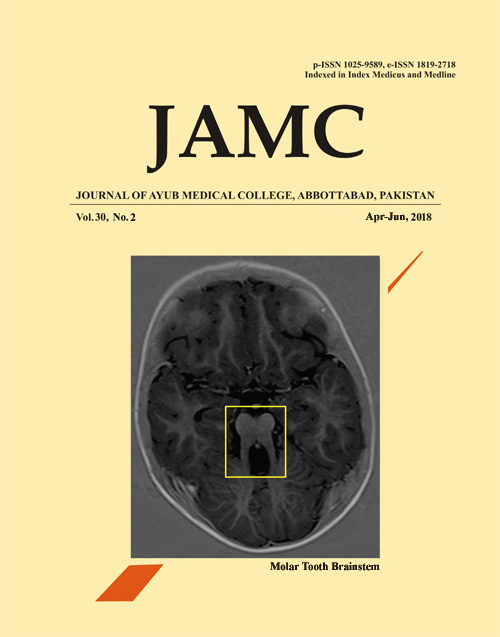SAMPLE SIZE DETERMINATION IN HEALTH RESEARCH
Abstract
One of frequently asked question by medical and dental students / researchers is how to determine the sample size. Sample size calculations is necessary for approval of research projects, clearance from ethical committees, approval of grant from funding bodies, publication requirement for journals and most important of all justify the authenticity of study results. Determining the sample size for a study is a crucial component. The goal is to include sufficient numbers of subjects so that statistically significant results can be detected. Using too few subjects' will result in wasted time, effort, money, animal lives etc. and may yield statistically inconclusive results. There are numerous situations in which sample size is determined that varies from study to study. This article will focus on the sample size determination for hypothesis testing that involves means, one sample t test, two independent sample t test, paired sample and one-way analysis of variance.
Keywords: Sample size; hypothesis testing; one sample t test; two independent sample tests; paired sample t test; one-way analysis of varianceReferences
Daniel WW. Biostatistics: a foundation for analysis in the health sciences 7th ed. New York NY: Wiley, 1999; p.180-5, 268-7.
Pagano M, Gauvreau K. Principles of biostatistics. Pacific Grove, Calif: Duxbury, 2000; p.246-9, 330-1.
Altman DG. Practical statistics for medical research. London, England: Chapman & Hall; 1991.
Freiman JA, Chalmers TC, Smith H Jr, Kuebler RR. The importance of beta, the type II error and sample size in the design and interpretation of the randomized control trial. N Engl J Med 1978;299(13):690-4.
Rosner B. Fundamentals of biostatistics 5th ed. Pacific Grove, Calif: Duxbury, 2000; p.308.
Feinstein AR. Principles of medical statistics. Boca Raton, Fla: CRC, 2002; p.503.
Snedecor GW, Cochran WG. Statistical methods 8th ed. Ames, Iowa: Iowa State University Press, 1989; p.52, 439.
SPSS. Sample Power. [internet]. [cited 2012 March 3]. Available from: www.spss.com/SPSSBI/SamplePower/
Frison L, Pocock S. Repeated measurements in clinical trials: analysis using mean summary statistics and its implications for design. Stat Med 1992;11(13):1685-1704.
Fleiss JL. Statistical methods for rates and proportions 2nd ed. New York, NY: Wiley, 1981; p.45.
Hoenig JM, Heisey DM. The abuse of power: the pervasive fallacy of power calculations for data analysis. Am Stat 2001;55:19-24.
Kirkpatric LA, Feeney BC. A Simple Guide to SPSS for Windows: Versions 8, 9, and 10. 4th ed. Wadsworth; 2000.
Roberts I, Kwan I, Evans P, Haig S. Does animal experimentation inform human healthcare? Observations from a systematic review of international animal experiments on fluid resuscitation. Br Med J 2002;324(7335):474-6.
Thornley B, Adams C. Content and Quality of 2000 Controlled Trials in Schizophrenia over 50 Years. BMJ 1998;317(7167):1181-4.
Wheeler RE. Portable Power. Technometrics 2001;16:193-201.
Wright T. A simple algorithm for tighter exact upper confidence bounds with rare attributes in finite universes. Stat Probab Lett 1999;36(1):59-67.
Lipsey MW. Design Sensitivity: Statistical Power for Experimental Research. Newbury Park, Calif: Sage Publications, 1990; p.207.
Mace AE. Sample-Size Determination, New York: Reinhold; 1964.
Muller KE, Benignus VA. Increasing Scientific Power with Statistical Power. Neurotoxicol Teratol 1992;14(3):211-9.
Gerstman BB. Basic Biostatistics: Statistics for public health practice. Boston: Jones & Bartlett Publishers; 2008.
Downloads
Published
How to Cite
Issue
Section
License
Journal of Ayub Medical College, Abbottabad is an OPEN ACCESS JOURNAL which means that all content is FREELY available without charge to all users whether registered with the journal or not. The work published by J Ayub Med Coll Abbottabad is licensed and distributed under the creative commons License CC BY ND Attribution-NoDerivs. Material printed in this journal is OPEN to access, and are FREE for use in academic and research work with proper citation. J Ayub Med Coll Abbottabad accepts only original material for publication with the understanding that except for abstracts, no part of the data has been published or will be submitted for publication elsewhere before appearing in J Ayub Med Coll Abbottabad. The Editorial Board of J Ayub Med Coll Abbottabad makes every effort to ensure the accuracy and authenticity of material printed in J Ayub Med Coll Abbottabad. However, conclusions and statements expressed are views of the authors and do not reflect the opinion/policy of J Ayub Med Coll Abbottabad or the Editorial Board.
USERS are allowed to read, download, copy, distribute, print, search, or link to the full texts of the articles, or use them for any other lawful purpose, without asking prior permission from the publisher or the author. This is in accordance with the BOAI definition of open access.
AUTHORS retain the rights of free downloading/unlimited e-print of full text and sharing/disseminating the article without any restriction, by any means including twitter, scholarly collaboration networks such as ResearchGate, Academia.eu, and social media sites such as Twitter, LinkedIn, Google Scholar and any other professional or academic networking site.










